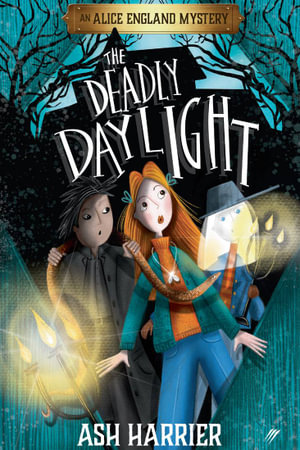The deadly daylight by Ash Harrier

12-year-old Alice England does not have the lifestyle of most girls her age. She lives in the same building where her father runs his funeral and undertaking business, and she works to assist him in preparing the deceased for their memorial farewells. Her own life has been shadowed by its own sadness. She is the surviving twin, although with a permanent impairment, from a difficult birth. Her mother abandoned the family early in Alice’s life, but Alice is incredibly close to her caring and staid father. And it seems that the dead also are able to hint their needs to her. This very unusual environment and her unusual personality leads others to give her a wide berth, but Alice is not very distressed by this. She has a formal, proper and almost sombre approach to life, and does not realise that she is unusual. Her complete honesty with her father adds a unique perspective to her pre-teen life. When George Devenish is brought to the funeral home it seems that Alice realises that his death on the sea-side quay is not all it seems. His unusual ‘sunshine’ allergy and anaphylaxis is not everything there is to know about his death. The otherworldly communication in the story is subtle, but leads Alice to begin investigating. She is also introduced to a potential, although unwilling, new ‘friend’ and companion in the inquiry in Violet Devenish (similarly allergic as her Uncle George). The investigation twists and turns, but it is Alice’s doggedness (and occasional tactlessness) despite opposition that leads her into unfamiliar territory and to an understanding of George’s death.
My concern for this book is for the readers who have experienced recent grief. The discussions about embalming and preparations for funerals are perhaps on the edge of macabre and may be a little raw for young readers struggling with their own losses. Alice has a personality that is both naive and mature, perhaps even eccentric and comical, but it is her unruffled and almost blase and nonchalant response to death that is the most unusual. The twists and turns in this mystery and the understanding of an unusual allergy are intriguing and keep readers turning the pages. There is also a connection to an environmental issue and to some teens who live a slightly edgy life on quayside. Although this book would introduce the murder mystery genre to a younger audience, and in some ways it has a similar, but more modern, appeal to the Enola Holmes series, I suspect that the environment of bereavement may need to be read by those aged at least 13+. School Libraries should recognise the need to protect some psychologically vulnerable readers.
Themes: Funerals, Murder mystery, Death, Allergies, Friendship, Smuggling, Resilience.
Carolyn Hull